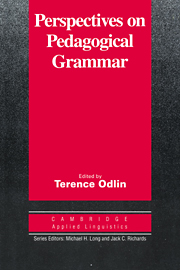Book contents
- Frontmatter
- Contents
- List of contributors
- Series editors' preface
- Preface
- Chapter 1 Introduction
- I WHAT SORT OF GRAMMAR?
- Chapter 2 Universal Grammar and the learning and teaching of second languages
- Chapter 3 Non-transformational theories of grammar: Implications for language teaching
- Chapter 4 Rules and pedagogical grammar
- II GRAMMAR, LEXICON, AND DISCOURSE
- III PUTTING GRAMMAR TO WORK
- Glossary
- Index
Chapter 2 - Universal Grammar and the learning and teaching of second languages
Published online by Cambridge University Press: 05 October 2012
- Frontmatter
- Contents
- List of contributors
- Series editors' preface
- Preface
- Chapter 1 Introduction
- I WHAT SORT OF GRAMMAR?
- Chapter 2 Universal Grammar and the learning and teaching of second languages
- Chapter 3 Non-transformational theories of grammar: Implications for language teaching
- Chapter 4 Rules and pedagogical grammar
- II GRAMMAR, LEXICON, AND DISCOURSE
- III PUTTING GRAMMAR TO WORK
- Glossary
- Index
Summary
This chapter has the general aim of describing the possible relationships between Universal Grammar and language teaching. It first sketches an overview of the principles and parameters theory of syntax and shows how this relates to the Universal Grammar (UG) model of language acquisition; it then describes some of the issues in applying the UG model to second language learning; it concludes by drawing some implications for language teaching.
Principles and parameters grammar
The Chomsky an UG model of acquisition is based on the theory of syntax known variously as principles and parameters theory or Government/Binding (GB) Theory, named after Chomsky's book Lectures on Government and Binding (Chomsky 1981a). The basic concept is that language is knowledge stored in the mind. This knowledge consists of principles that do not vary from one person to another and parameter settings that vary according to the particular language that the person knows. Principles and parameters theory can be approached through an analogy to a video recorder. A recorder needs two elements in order to function: the unchanging equipment itself, which is the same in every set that is sold, and the variable tuning, which has to be set by the user to local circumstances. When a new recorder is switched on, everything may be in working order, but nothing appropriate will show on the screen until the channels have been tuned to the local TV stations. The combination of the two elements of permanent equipment and particular tuning allows the recorder to function in any situation.
- Type
- Chapter
- Information
- Perspectives on Pedagogical Grammar , pp. 25 - 48Publisher: Cambridge University PressPrint publication year: 1994
- 7
- Cited by



